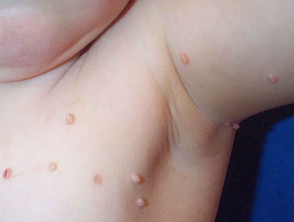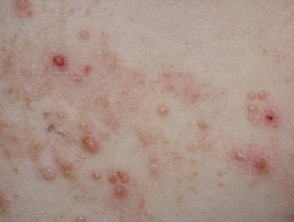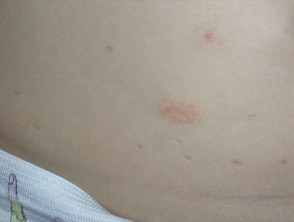DermNet provides Google Translate, a free machine translation service. Note that this may not provide an exact translation in all languages
Home Viral skin infections Molluscum contagiosum CME
Viral skin infections
Molluscum contagiosum
Created 2009.
Learning objectives
- Identify and manage molluscum contagiosum
Clinical features
Molluscum contagiosum is a common cutaneous infection due a pox virus. It mainly presents in childhood as multiple soft umbilicated papules. Thick white material can be expressed from the middle of the papules. They are often clustered in the flexures especially axillae and genital areas.
Molluscum contagiosum often provokes localised eczema, particularly in atopic children.
As the lesions resolve the papules may become inflamed (red and crusted) or necrotic (black scabs) and may leave punctate scars.
Untreated, the papules resolve after a few months. They rarely persist for longer than two years.
Molluscum contagiosum
Investigations
In general, no investigations are necessary and the diagnosis is made clinically. However, a skin biopsy may be helpful. Characteristic features are:
- Epidermal hyperplasia
- Central crater filled with molluscum bodies (huge eosinophilic to basophilic intracytoplasmic inclusions)
- No inflammation in intact lesions; dense inflammatory response in ruptured lesions
Management
Treatment may not be necessary or advisable in the majority of young children. Options include:
- Emollients and mild topical steroids (usually hydrocortisone cream) to reduce itching and eczema
- In older children or adults the lesions can be removed individually. Methods include:
- Expressing lesion contents using forceps
- Curettage after EMLA application
- Prick out the centre with a sharp stick
- Light cryotherapy
- Cantharidine solution, covered with a plaster and washed off 2-4 hours later
- Imiquimod cream, applied three times weekly for four weeks or so
Activity
Describe the impact and treatment of molluscum contagiosum in patients infected by human immunodeficiency virus.
Related information
References:
On DermNet NZ:
Information for patients
Other websites:
- Medscape Reference: Molluscum contagiosum
- Dermatology Online Journal: Molluscum contagiosum
- Merck Manual Professional: Molluscum Contagiosum
Books about skin diseases:
See the DermNet NZ bookstore
Sign up to the newsletter
© 2024 DermNet.
DermNet does not provide an online consultation service. If you have any concerns with your skin or its treatment, see a dermatologist for advice.


